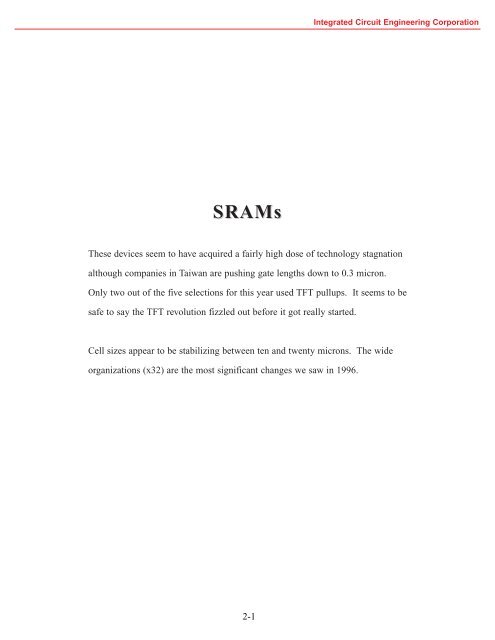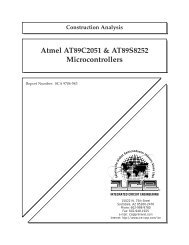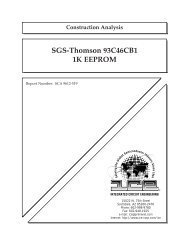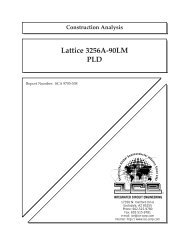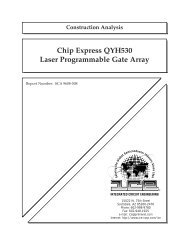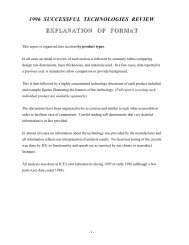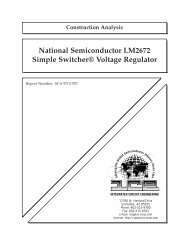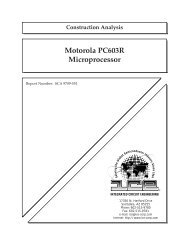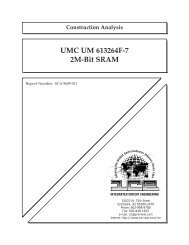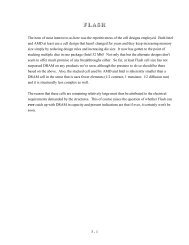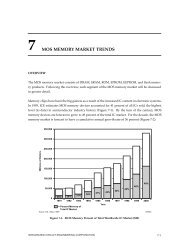SRAMs - Smithsonian - The Chip Collection
SRAMs - Smithsonian - The Chip Collection
SRAMs - Smithsonian - The Chip Collection
Create successful ePaper yourself
Turn your PDF publications into a flip-book with our unique Google optimized e-Paper software.
<strong>SRAMs</strong><br />
<strong>The</strong>se devices seem to have acquired a fairly high dose of technology stagnation<br />
although companies in Taiwan are pushing gate lengths down to 0.3 micron.<br />
Only two out of the five selections for this year used TFT pullups. It seems to be<br />
safe to say the TFT revolution fizzled out before it got really started.<br />
Cell sizes appear to be stabilizing between ten and twenty microns. <strong>The</strong> wide<br />
organizations (x32) are the most significant changes we saw in 1996.<br />
2-1<br />
Integrated Circuit Engineering Corporation
<strong>SRAMs</strong><br />
Die size<br />
Min. M2 width/space<br />
Min. M1 width/space<br />
Min. via (Met. to Met)<br />
Min contact (Met. to Si)<br />
Min. Poly 4<br />
Min. Poly 3<br />
Min. Poly 2<br />
Min. Poly 1<br />
Min. gate-(N)†<br />
Min. gate-(P)†<br />
Cell pitch<br />
Cell area<br />
* Polycide + Plugs † Physical gate length<br />
HORIZONTAL DIMENSIONS (DESIGN RULES)<br />
UMC<br />
UM61L3264F-7<br />
2Mb (x32)<br />
9631<br />
6.1 x 6.7mm<br />
(41mm2)<br />
0.6µm/0.6µm<br />
0.6µm/0.6µm<br />
0.5µm<br />
0.5µm<br />
NA<br />
NA<br />
0.6µm<br />
0.3µm*<br />
0.3µm<br />
0.4µm<br />
2.5µm x 4.5µm<br />
11.25µm2 Tm TECH<br />
T32L3232A-7Q<br />
1Mb (x32)<br />
9530<br />
5.9 x 6.0mm<br />
(35mm2)<br />
0.75µm/0.75µm<br />
0.85µm/0.75µm<br />
0.7µm<br />
0.6µm +<br />
NA<br />
NA<br />
0.4µm<br />
0.35µm*<br />
0.35µm<br />
0.35µm<br />
4.15µm x 4.65µm<br />
19µm2 Table 2-1<br />
WINBOND<br />
W25P010AF-8<br />
1Mb (x32)<br />
9612<br />
5.0 x 6.5mm<br />
(32.5mm2)<br />
0.95µm/0.85µm<br />
0.65µm/0.85µm<br />
0.75µm<br />
0.8µm<br />
NA<br />
NA<br />
0.7µm<br />
0.45µm<br />
0.45µm<br />
0.55µm<br />
4.0µm x 4.7µm<br />
19.6µm2 SAMSUNG<br />
KM684000ALG-7<br />
4Mb (x8)<br />
9606<br />
6.6 x 11.8mm<br />
(78mm2)<br />
1.4µm/1.4µm<br />
0.6µm/0.8µm<br />
1.3µm<br />
0.85µm<br />
0.4µm<br />
0.8µm<br />
0.35µm*<br />
0.65µm<br />
0.65µm<br />
0.8µm<br />
2.6µm x 4.5µm<br />
11.7µm2 SONY<br />
CXK5B16120J-12<br />
1Mb (x16)<br />
9604<br />
5.6 x 10.6mm<br />
(59mm2)<br />
2.0µm/2.9µm<br />
0.6µm/1.0µm<br />
1.6µm<br />
0.7µm<br />
0.4µm<br />
0.7µm<br />
0.5µm*<br />
0.5µm*<br />
0.5µm<br />
0.55µm<br />
3.7µm x 5.4µm<br />
20µm2 Integrated Circuit Engineering Corporation
<strong>SRAMs</strong><br />
Die Coat<br />
Final passivation<br />
Metal 2<br />
Metal 1<br />
Intermetal dielectric<br />
Poly 4<br />
Poly 3<br />
Poly 2<br />
Poly 1<br />
Recessed oxide<br />
N-well<br />
P-well<br />
UMC<br />
UM61L3264F-7<br />
2Mb (x32)<br />
9631<br />
None<br />
1.0µm<br />
1.0µm<br />
0.75µm<br />
1.2µm<br />
NA<br />
NA<br />
0.015µm<br />
0.3µm*<br />
0.3µm<br />
NA<br />
3.5µm<br />
* Polycide ❶ Could not delineate. ❷P-well inside N-well in array area.<br />
VERTICAL DIMENSIONS<br />
Tm TECH<br />
T32L3232A-7Q<br />
1Mb (x32)<br />
9530<br />
None<br />
0.75µm<br />
0.95µm<br />
0.6µm<br />
0.65µm<br />
NA<br />
NA<br />
0.04µm<br />
0.25µm*<br />
0.4µm<br />
NA<br />
3µm<br />
None<br />
0.85µm<br />
0.9µm<br />
0.65µm<br />
0.5µm<br />
NA<br />
NA<br />
0.08µm<br />
0.3µm<br />
0.4µm<br />
3.5µm<br />
NA<br />
Table 2-2<br />
WINBOND<br />
W25P010AF-8<br />
1Mb (x32)<br />
9612<br />
SAMSUNG<br />
KM684000ALG-7<br />
4Mb (x8)<br />
9606<br />
9.5µm<br />
0.6µm<br />
0.9µm<br />
0.9µm<br />
0.85µm<br />
0.02µm<br />
0.1µm<br />
0.2µm*<br />
0.15µm<br />
0.35µm<br />
6µm<br />
?❶3µm❷<br />
SONY<br />
CXK5B16120J-12<br />
1Mb (x16)<br />
9604<br />
15µm<br />
0.9µm<br />
1.1µm<br />
0.45µm<br />
0.5µm<br />
0.03µm<br />
0.04µm<br />
0.09µm*<br />
0.15µm*<br />
0.25µm<br />
2µm<br />
?❶<br />
Integrated Circuit Engineering Corporation
<strong>SRAMs</strong><br />
Final passivation<br />
Metal 2<br />
Metal 1<br />
Plugs<br />
Intermetal dielectric<br />
Pre-metal glass<br />
Polycide metal<br />
Die coat<br />
UMC<br />
UM61L3264F-7<br />
2Mb (x32)<br />
9631<br />
Nitride on glass<br />
Titanium-Nitride<br />
Aluminum<br />
Titanium<br />
Titanium-Nitride<br />
Aluminum<br />
Titanium-Nitride<br />
Titanium<br />
NA<br />
glass/SOG/glass<br />
BPSG<br />
Tungsten<br />
NA<br />
DIE MATERIALS<br />
Tm TECH<br />
T32L3232A-7Q<br />
1Mb (x32)<br />
9530<br />
Nitride on glass<br />
Titanium-Nitride<br />
Aluminum<br />
Titanium<br />
Titanium-Nitride<br />
Aluminum<br />
Titanium-Nitride<br />
Titanium<br />
Tungsten<br />
glass/SOG/glass<br />
BPSG<br />
Tungsten<br />
NA<br />
Table 2-3<br />
WINBOND<br />
W25P010AF-8<br />
1Mb (x32)<br />
9612<br />
Nitride on glass<br />
Titanium-Nitride<br />
Aluminum<br />
Titanium<br />
Titanium-Nitride<br />
Aluminum<br />
Titanium-Nitride<br />
Titanium<br />
NA<br />
glass/SOG/glass<br />
BPSG<br />
NA<br />
NA<br />
SAMSUNG<br />
KM684000ALG-7<br />
4Mb (x8)<br />
9606<br />
Nitride on glass<br />
Aluminum<br />
Titanium-Nitride<br />
Aluminum<br />
Titanium-Nitride<br />
Titanium<br />
NA<br />
glass/SOG/glass<br />
BPSG<br />
Tungsten<br />
Polyimide<br />
SONY<br />
CXK5B16120J-12<br />
1Mb (x16)<br />
9604<br />
Nitride<br />
Aluminum<br />
Titanium<br />
Titanium-Nitride<br />
Aluminum<br />
Titanium-Nitride<br />
Titanium<br />
NA<br />
glass/SOG/glass<br />
BPSG<br />
Tungsten<br />
Polyimide<br />
Integrated Circuit Engineering Corporation
UMC UM61L3264F-7<br />
TECHNOLOGY DESCRIPTION<br />
UMC UM61L3264F-7<br />
Synchronous 2Mbit (64K x 32) CMOS SRAM<br />
Introduction Ref. report SCA 9609-511<br />
<strong>The</strong>se parts were packaged in 100-pin Quad Flat Packs (QFPs) with gull-wing leads. <strong>The</strong>y were<br />
fully functional production devices organized in a 64K word x 32-bit design and provide synchronous<br />
operation. <strong>The</strong> date code was 9631 (week 31 of 1996).<br />
See tables for specific dimensions and materials identification and see figures for examples of<br />
physical structures.<br />
Important/Unique Features<br />
– Most aggressive design rules (smallest cell size seen in 1996)!<br />
– Relatively uncomplicated process.<br />
Quality<br />
Quality of the process implementation was very good. No areas of concern were found anywhere.<br />
In the area of layer patterning, etch definition and control were both good.<br />
Alignment and registration were also good.<br />
Technology<br />
<strong>The</strong>se devices were manufactured by a P-well, selective oxidation CMOS process on an N substrate<br />
(no epi). <strong>The</strong>y employ two levels of metal and two levels of poly.<br />
Passivation consisted of a layer of nitride over silicon-dioxide.<br />
Integrated Circuit Engineering Corporation<br />
<strong>The</strong> two levels of metal were defined by standard dry-etch techniques. Metal 2 consisted of<br />
aluminum with a titanium-nitride cap and titanium barrier. Metal 1 also employed a titaniumnitride<br />
cap and barrier and a thin titanium adhesion layer under the barrier.<br />
2-2
UMC UM61L3264F-7<br />
Aluminum filled standard style vias were used for vertical interconnect between M2 and M1,<br />
while tungsten plugs were used at contacts between M1 and silicon. Since via holes were of<br />
very small diameter and the aluminum of metal 2 was quite thick, we could not determine with<br />
certainly whether an aluminum reflow was used or if vias were simply filled during the deposition<br />
process.<br />
<strong>The</strong> tungsten plugs all used liners under the tungsten only (none between the tungsten and the<br />
M1 aluminum).<br />
Intermetal dielectric between metal 2 and metal 1 consisted of two layers of glass with a spinon-glass<br />
(SOG) between for planarization. <strong>The</strong> SOG had been subjected to an etchback.<br />
Pre-metal dielectric was a single layer of reflow glass (BPSG) over densified oxides. This layer<br />
was reflowed prior to contact cuts.<br />
Two layers of polysilicon were used. Poly 2 was only used in the memory array. Polycide 1<br />
(poly 1 and tungsten silicide) was used to form all gates and fuses on the die. No unusual<br />
structures were noted.<br />
Oxide sidewall spacers were used on the gates and were left in place. Buried contacts were<br />
only used in the cell array (see below).<br />
No evidence of unusual gate oxides or other dielectrics was found. Standard LOCOS<br />
isolation was employed and well implemented. No step was present and no other signs of twinwells<br />
was found.<br />
Polycide 1 redundancy fuses were present. Passivation and oxide were cleared over the fuse<br />
locations. No blown fuses were noted.<br />
Standard source/drain implants were used (not silicided) and we found no evidence of anything<br />
but the single type P-wells.<br />
Memory Cell Structures<br />
Integrated Circuit Engineering Corporation<br />
Memory cells consisted of a standard 4T NMOS SRAM cell design. Polycide 1 formed word<br />
lines, select and storage gates. Metal 2 distributed GND and metal 1 formed the bit lines.<br />
2-3
UMC UM61L3264F-7<br />
Selectively doped poly 2 formed the pull-up resistors and distributed Vcc and was used for contact<br />
pads at bit contacts. <strong>The</strong> SRAM cell size was 11.25 microns2 , the smallest cell size seen in<br />
1996! Gate length of the select transistors in the cell was 0.55 micron.<br />
Overall minimum feature size measured anywhere on these dice was the 0.3 micron poly used<br />
for some N-channel gates.<br />
Packaging/Assembly<br />
As mentioned, these parts were packaged in 100-pin Quad Flat Packs (QFPs) with gull-wing<br />
leads date coded 9631 (week 31 of 1996)<br />
<strong>The</strong> die was mounted to the paddle with silver-epoxy die attach. Wirebond pads on the die had<br />
a pitch of 125 microns with 20 micron spacing. Pads were 105 microns wide with a 100<br />
micron windows.<br />
No die coat was used on these devices.<br />
2-4<br />
Integrated Circuit Engineering Corporation
UMC UM61L3264F-7<br />
Whole die photograph of the UMC UM61L3264F-7. Mag. 26x.<br />
Integrated Circuit Engineering Corporation
UMC UM61L3264F-7<br />
PASSIVATION 2<br />
PASSIVATION 1<br />
METAL 2<br />
POLY 1<br />
PRE-METAL<br />
DIELECTRIC<br />
Mag. 13,000x<br />
INTERLEVEL DIELECTRIC<br />
METAL 1<br />
W PLUG<br />
Mag. 26,000x<br />
PLUG<br />
N +S/D<br />
SEM section views illustrating general structure.<br />
Integrated Circuit Engineering Corporation<br />
METAL 1<br />
POLY 1
UMC UM61L3264F-7<br />
BIT<br />
1<br />
BIT<br />
WORD<br />
2<br />
WORD<br />
POLY 1<br />
SELECT<br />
GATE<br />
BIT LINE CONTACT<br />
R1<br />
POLY 2 “PULL UP”<br />
RESISTOR<br />
Perspective and section SEM views of SRAM cell array. Mag. 13,000x.<br />
R2<br />
4<br />
3<br />
V CC<br />
Integrated Circuit Engineering Corporation<br />
V CC<br />
GND<br />
GND<br />
delayered, 0°<br />
delayered, 60°
tm Tech T32L3232A-7Q<br />
TECHNOLOGY DESCRIPTION<br />
Tm TECH T32L3232A-7Q<br />
Synchronous Burst<br />
1Mbit (32K x 32) CMOS SRAM<br />
Introduction Ref. report SCA 9602-449<br />
<strong>The</strong>se parts were packaged in 100-pin plastic Thin Quad Flat Packs (TQFPs) with gull-wing<br />
leads. <strong>The</strong>y were fully functional production devices organized in a 32K word x 32-bit design<br />
providing synchronous burst operation. <strong>The</strong>se parts offer a 7 nsec. access time and they operate<br />
from a 3.3V power source. <strong>The</strong>y were date coded 9530 (week 30 of 1995).<br />
See tables for specific dimensions and materials identification and see figures for examples of<br />
physical structures.<br />
Important/Unique Features<br />
– Standard CMOS with tungsten plugs, SOG planarization, and 4T cells.<br />
– Sub-micron gate lengths (0.35 micron).<br />
Quality<br />
Quality of the process implementation was good although metal 2 thinned up to 85 percent at<br />
vias.<br />
In the area of layer patterning, etch definition and control were both good.<br />
Alignment and registration were also good.<br />
Technology<br />
<strong>The</strong>se devices were manufactured by a P-well, selective oxidation CMOS process on an N substrate<br />
(no epi). <strong>The</strong>y employed two levels of metal and two levels of poly.<br />
Final passivation consisted of a layer of nitride over silicon-dioxide.<br />
2-5<br />
Integrated Circuit Engineering Corporation
tm Tech T32L3232A-7Q<br />
<strong>The</strong> two levels of metal were defined by standard dry-etch techniques. Both consisted of aluminum<br />
with titanium-nitride caps. Metal 2 had a titanium barrier/adhesion layer, while metal 1<br />
employed a titanium adhesion layer under a titanium-nitride barrier.<br />
Vertical interconnect between metal 2 and metal 1 employed standard vias. Metal 1 used tungsten<br />
plugs at all contacts to silicon. <strong>The</strong> plugs appeared to have a titanium-nitride on titanium<br />
liner underneath only. No sign of any layer between the tungsten and aluminum 1 above it was<br />
observed.<br />
Intermetal dielectric between metal 2 and metal 1 consisted of three layers of glass including a<br />
spin-on-glass (SOG) for planarization. <strong>The</strong> SOG had been subjected to an etchback. It was<br />
located between two standard deposited layers (TEOS?).<br />
Pre-metal dielectric was a single layer of reflow glass (BPSG) over densified oxides. <strong>The</strong> BPSG<br />
was reflowed prior to contact cuts only.<br />
Two layers of polysilicon were used. Poly 2 was used to form the pull-up resistors in the array.<br />
Polycide 1 (poly 1 and tungsten silicide) was used to form all gates and fuses on the die. No<br />
unusual features were present.<br />
Oxide sidewall spacers were used and were left in place.<br />
Buried contacts were used only at poly 2 resistors in the cell array.<br />
No evidence of unusual gate oxides or other dielectrics was found. Standard LOCOS isolation<br />
was employed and well implemented. No step was present in the LOCOS and no other indications<br />
of the use of twin-wells was found.<br />
Polycide 1 redundancy fuses were present. Passivation and oxide was cleared over the fuse<br />
locations. No blown fuses were present.<br />
Standard source/drain implants were used and we only found evidence of the single type Pwells.<br />
Diffusions were not silicided.<br />
Memory Cell Structures<br />
Integrated Circuit Engineering Corporation<br />
Memory cells consisted of a standard 4T NMOS SRAM design. Polycide 1 formed word lines,<br />
select and storage gates. Metal 2 was used as “piggyback” word lines (via metal 1 links). Metal<br />
1 formed bit lines throughout the array and also distributed GND. Selectively doped poly 2<br />
2-6
tm Tech T32L3232A-7Q<br />
formed the pull-up resistors and distributed Vcc. Poly 2 also provided the interpoly/buried<br />
interconnection. Select gates were 0.45 micron long while the cell size was 19 microns2 .<br />
Overall minimum feature size measured anywhere on the die was the 0.35 micron poly used for<br />
both P and N-channel gates.<br />
Packaging/Assembly<br />
As mentioned, parts were packaged in 100-pin plastic Thin Quad Flat Packs (TQFPs) with gullwing<br />
leads date coded 9530.<br />
<strong>The</strong> die was mounted to the paddle with silver-epoxy die attach. Wirebond pads on the die had<br />
a pitch of 160 microns with 50 micron spacing. Pads were 110 microns wide with 9 micron<br />
windows. Both metal 1 and metal 2 were present and in direct contact in the entire pad areas.<br />
No die coat was used.<br />
2-7<br />
Integrated Circuit Engineering Corporation
tm Tech T32L3232A-7Q<br />
PIN 2<br />
<strong>The</strong> tm Tech T32L3232A-7Q intact circuit die. Mag. 30x.<br />
Integrated Circuit Engineering Corporation
tm Tech T32L3232A-7Q<br />
POLISHING<br />
ARTIFACT<br />
LOCAL OXIDE<br />
PASSIVATION<br />
INTERLEVEL DIELECTRIC<br />
POLYCIDE 1 GATE<br />
TiN BARRIER 1<br />
Mag. 13,000x<br />
Mag. 40,000x<br />
METAL<br />
2<br />
METAL 1<br />
W<br />
PLUG<br />
SEM section views illustrating general construction. Silicon etch.<br />
N+<br />
W<br />
PLUG<br />
ALUMINUM 1<br />
P+<br />
Integrated Circuit Engineering Corporation<br />
SOG<br />
TiN CAP 1<br />
INTERMEDIATE GLASS<br />
POLYCIDE 1
tm Tech T32L3232A-7Q<br />
BIT<br />
Example of poly 1 structures. Mag. 10,000x, 0°.<br />
BIT<br />
“PIGGYBACK”<br />
WORD LINES<br />
POLYCIDE 1<br />
SELECT GATE<br />
N+<br />
1<br />
2<br />
GND<br />
R1<br />
4<br />
R2<br />
INTERLEVEL DIELECTRIC<br />
W<br />
PLUG<br />
METAL 1<br />
3<br />
V CC<br />
PASSIVATION<br />
METAL 2<br />
POLY 2 RESISTOR<br />
Topological and section SEM views of the tm Tech SRAM cell.<br />
Integrated Circuit Engineering Corporation<br />
unlayered,<br />
Mag. 13,000x, 0°<br />
Mag. 10,000x
Winbond W25P010AF-8<br />
TECHNOLOGY DESCRIPTION<br />
WINBOND W25P010AF-8<br />
Synchronous Burst<br />
1Mbit (32K x 32) CMOS SRAM<br />
Introduction Ref. report SCA 9612-492<br />
<strong>The</strong> parts were packaged in 100-pin plastic Quad Flat Packs (QFPs) with gull wing leads. <strong>The</strong>y<br />
were fully functional production devices organized in a 32K word x 32-bit design providing<br />
synchronous burst operation. <strong>The</strong>y have an 8 nsec. access time and operate from a 3.3V power<br />
source. <strong>The</strong>y were date coded 9612 (week 12 of 1996)<br />
See tables for specific dimensions and materials identification and see figures for examples of<br />
physical structures.<br />
Important/Unique Features<br />
– Standard N-well CMOS with SOG planarization (no CMP).<br />
– Sub-micron gate lengths (0.45 micron).<br />
Quality<br />
Quality of the process implementation was normal to poor. Some 95 to 100 percent aluminum<br />
thinning was noted at metal contacts and vias.<br />
In the area of layer patterning, etch definition was normal to poor, while control was good.<br />
Alignment and registration was normal.<br />
Technology<br />
<strong>The</strong>se devices were manufactured by an N-well, selective oxidation CMOS process on a P substrate<br />
(no epi). <strong>The</strong>y employ two levels of metal and two levels of poly.<br />
Passivation consisted of a layer of nitride over glass.<br />
2-8<br />
Integrated Circuit Engineering Corporation
Winbond W25P010AF-8<br />
<strong>The</strong> two levels of metal were defined by standard dry-etch techniques. Metal 2 consisted of<br />
aluminum with a titanium-nitride cap and titanium barrier. Metal 1 was also aluminum and<br />
employed a titanium-nitride cap and barrier, plus a titanium adhesion layer under the barrier.<br />
Standard contacts and vias were used for vertical interconnect (no plugs).<br />
Interlevel dielectric between metal 2 and metal 1 consisted of two layers of glass with a spinon-<br />
glass (SOG) between for planarization. <strong>The</strong> SOG had been subjected to an etchback.<br />
Pre-metal dielectric was a single layer of reflow glass (BPSG) over densified oxides. This layer<br />
was reflowed prior to contact cuts only.<br />
Two levels of polysilicon were used. Poly 2 was used only in the memory array. Poly 1 was<br />
used to form all gates and fuses on the die. Both consisted of standard polysilicon (no silicide).<br />
Oxide sidewall spacers were used on the gates and were left in place.<br />
Both poly 1 and poly 2 made direct contact to N+ diffusions (buried contacts) and poly 2 also<br />
made direct contact to poly 1.<br />
No evidence of unusual gate oxides or other dielectrics was found. Standard LOCOS<br />
isolation was employed and well implemented. No step was present in the LOCOS and no<br />
other signs of the presence of twin-wells was found.<br />
Standard source/drain implants were used (not silicided).<br />
Polycide 1 redundancy fuses were present. Passivation and most dielectric were cleared over the<br />
fuse locations. No blown fuses were noted.<br />
Memory Cell Structures<br />
Integrated Circuit Engineering Corporation<br />
Memory cells consisted of a standard 4T NMOS SRAM cell design. Poly 1 formed word lines,<br />
select and storage gates. Metal 2 formed “piggyback” word lines and distributed GND (via<br />
metal 1). Metal 1 was used to form bit lines. Selectively doped poly 2 formed the pull-up resistors<br />
and distributed Vcc. <strong>The</strong> SRAM cell size was 19.6 microns2 .<br />
Overall minimum feature size measured anywhere on these dice was the 0.45 micron poly (Nchannel<br />
gates).<br />
2-9
Winbond W25P010AF-8<br />
Packaging/Assembly<br />
As mentioned, these parts were packaged in 100-pin plastic Quad Flat Packs (QFPs) with gullwing<br />
leads date coded 9612 (week 12 of 1996)<br />
<strong>The</strong> die was mounted to the paddle with silver-epoxy die attach. Wirebond pads on the die had<br />
a pitch of 145 microns with 45 micron spacing. Pads were 100 microns wide with 90 micron<br />
windows.<br />
No die coat was used.<br />
2-10<br />
Integrated Circuit Engineering Corporation
Winbond W25P010AF-8<br />
Whole die photograph of the Winbond W25P010AF-8 SRAM. Mag. 35x.<br />
Integrated Circuit Engineering Corporation
Winbond W25P010AF-8<br />
METAL 1<br />
P+ S/D<br />
PASSIVATION 1<br />
POLY 1<br />
POLY 1<br />
GATE<br />
GATE OXIDE<br />
PASSIVATION 2<br />
METAL 2<br />
SOG<br />
N+ S/D<br />
P+ S/D<br />
SEM section views illustrating general device structures.<br />
Integrated Circuit Engineering Corporation<br />
POLY GATE<br />
silicon etch,<br />
Mag. 10,000x<br />
Mag. 4600x, 60°<br />
P-channel,<br />
Mag. 26,000x
Winbond W25P010AF-8<br />
BIT<br />
BIT<br />
1<br />
2<br />
POLY 1<br />
SOG<br />
N+ S/D<br />
POLY 2<br />
N+ S/D<br />
R2<br />
R1<br />
POLY 1<br />
GATE<br />
SOG<br />
V CC<br />
Topological and section SEM views of SRAM cell.<br />
4<br />
3<br />
METAL 1 BIT LINE<br />
POLY 2<br />
N+ S/D<br />
POLY 1 GATE<br />
N+ S/D<br />
Integrated Circuit Engineering Corporation<br />
unlayered,<br />
Mag. 13,000x, 0°<br />
parallel to bit lines,<br />
Mag. 24,000x<br />
perpendicular to bit lines,<br />
Mag. 26,000x
Samsung KM68400ALG-7<br />
TECHNOLOGY DESCRIPTION<br />
SAMSUNG KM684000ALG-7<br />
4Mbit (x8) CMOS SRAM<br />
Introduction Ref. report SCA 9612-512<br />
<strong>The</strong>se parts were packaged in 32-pin plastic Small Outline Packages (SOPs) with gull-wing<br />
leads. <strong>The</strong>y were fully functional production devices organized in a 512K word x 8-bit design<br />
and offer a 70nsec access time. <strong>The</strong>se parts operate from a 3.0 to 3.6V power source. <strong>The</strong> date<br />
code was 606Y (week 6 of 1996)<br />
See tables for specific dimensions and materials identification and see figures for examples of<br />
physical structures.<br />
Important/Unique Features<br />
– Relatively unaggressive design rules but almost the smallest cell seen in 1996.<br />
– Very complex four layer poly process.<br />
– Thin-film stacked PMOS load transistor (TFT) SRAM cell.<br />
– Reflowed aluminum 1 contacts.<br />
Quality<br />
Quality of the process implementation was very good. We found no areas of concern.<br />
In the area of layer patterning, etch definition and control were both good.<br />
Alignment and registration were also good.<br />
Technology<br />
<strong>The</strong>se devices were manufactured by a twin (multiple)-well, selective oxidation CMOS process<br />
on a P substrate (no epi). <strong>The</strong>y employ two levels of metal and four levels of poly.<br />
Passivation consisted of a thick nitride over a thin layer of glass.<br />
2-11<br />
Integrated Circuit Engineering Corporation
Samsung KM68400ALG-7<br />
<strong>The</strong> two levels of metal were defined by standard dry-etch techniques. Metal 2 consisted of aluminum<br />
(no cap or barrier layer). Metal 1 was aluminum with a titanium-nitride cap and barrier<br />
on a thin titanium adhesion layer.<br />
Standard vias were used under metal 2, but metal 1 used reflowed aluminum contacts (no<br />
plugs). <strong>The</strong>se are typical of Samsung’s process.<br />
Intermetal dielectric between metal 2 and metal 1 consisted of a multilayered glass followed by<br />
a spin-on-glass (SOG) for planarization, covered by another layer of glass (no CMP).<br />
Pre-metal dielectric used two layers of reflow glass (BPSG) in the memory array area, but<br />
apparently only one layer in the periphery. Each of these layers had a thin layer of nitride<br />
underneath (for which we could not determine the specific purpose). Poly 1 and 2 were located<br />
under the first pair of these dielectrics, poly 3 and 4 were located under the second pair.<br />
Four layers of polysilicon were used. Poly 4 and poly 3 were used in the cell array only.<br />
Polycide 2 (poly 2 and tungsten silicide) was used to distribute word lines and ground in the<br />
array. It was also used as a layer of interconnect throughout the peripheral circuitry. In addition,<br />
polycide 2 formed the redundancy fuses and was used for some special structures we could not<br />
define (most appeared to shield poly 1 gates). Poly 1 formed all standard gates on the die.<br />
Sidewall spacers were of oxide and were left in place.<br />
Integrated Circuit Engineering Corporation<br />
Buried contacts were formed by poly 2 to N+ and, poly 4 and 3 formed interpoly/buried contacts<br />
in the cell array only.<br />
No evidence of unusual gate oxides was found. Standard LOCOS isolation was employed and<br />
well implemented. A step in this LOCOS was present at well boundaries.<br />
Polycide 2 redundancy fuses were present. Passivation and oxide was cleared over the fuse<br />
locations, and some laser blown fuses were noted.<br />
Standard source/drain implants were used but wells included both deep and shallow P-wells.<br />
<strong>The</strong> shallow P-wells were located inside N-wells and were used in the memory array areas. Pwells<br />
were also used in the periphery but could not be delineated.<br />
Overall minimum feature size measured anywhere on these dice was the 0.4 micron poly 4.<br />
Minimum gate length was 0.65 micron (N-channel).<br />
2-12
Samsung KM68400ALG-7<br />
Memory Cell Structures<br />
Memory cells consisted of two select gates, two storage gates, two PMOS thin film<br />
transistors, and some apparent cross-coupling capacitor regions. Metal 1 formed the bit lines.<br />
Poly 1 was used for all the gates. Polycide 2 distributed ground (supplied from metal 1 and 2).<br />
Polycide 2 also formed the word lines. Poly 3 formed the PMOS thin film transistor (TFT)<br />
gates and was used as an interconnect for bit line contacts. Poly 4 formed the TFT bodies and<br />
provided Vcc distribution. <strong>The</strong> SRAM cell size was 11.7 microns2 .<br />
A P-well within a deep N-well was present beneath the array only.<br />
Packaging/Assembly<br />
As mentioned, these parts were packaged in 32-pin 400 mil plastic Small Outline Packages<br />
(SOPs) with gull-wing leads date coded 9606.<br />
<strong>The</strong> die was mounted to the paddle with silver-epoxy die attach. Wirebond pads on the die had<br />
a pitch of 200 microns with 80 micron spacing. Pads were 120 microns wide with 100 micron<br />
windows.<br />
A patterned polyimide die coat was used.<br />
2-13<br />
Integrated Circuit Engineering Corporation
Samsung KM68V4000 ALG-7<br />
Integrated Circuit Engineering Corporation<br />
Whole die photograph of the Samsung KM68400ALG-7 intact circuit die. Mag. 20x.
Samsung KM68V4000 ALG-7<br />
METAL 1<br />
PRE-METAL GLASS<br />
LOCAL OXIDE<br />
Mag. 6500x, 60°<br />
ILD<br />
POLY 1<br />
PASSIVATION<br />
METAL 2<br />
silicon etch, Mag. 13,000x<br />
POLYCIDE 2<br />
POLY 1<br />
Topological and section SEM views illustrating general construction.<br />
Integrated Circuit Engineering Corporation<br />
POLYCIDE 2
Samsung KM68V4000 ALG-7<br />
V CC<br />
POLY 2<br />
6<br />
POLYCIDE 2<br />
WORD LINE<br />
POLY 4<br />
GND<br />
Mag. 13,000x, 0°<br />
ALUMINUM 1<br />
POLY 1 SELECT<br />
GATE<br />
Mag. 26,000x<br />
V CC<br />
POLY 3<br />
Topological and section SEM views of the SRAM cell.<br />
5<br />
POLY 3<br />
Integrated Circuit Engineering Corporation<br />
CAP 1<br />
BARRIER 1<br />
POLY 4
Sony CXK5B16120J-12<br />
TECHNOLOGY DESCRIPTION<br />
SONY CXK5B16120J-12<br />
1Mbit (64K x 16) BiCMOS SRAM<br />
Introduction Ref. report SCA 9612-523<br />
<strong>The</strong> parts were packaged in 44-pin plastic Small Outline J-lead (SOJ) packages. <strong>The</strong>y were<br />
fully functional production devices organized in a 64K word x 16 bit asynchronous design and<br />
operate from a 3.3V power source. <strong>The</strong> date code was 9604 (week 4 of 1996)<br />
See tables for specific dimensions and materials identification and see figures for examples of<br />
physical structures.<br />
Important/Unique Features<br />
– Very complex BiCMOS process.<br />
– Sub-micron gate lengths (0.5 micron).<br />
– TFT pull-up devices in the SRAM array.<br />
Quality<br />
Quality of the process implementation was poor. Metal 1 aluminum at contacts thinned up to<br />
100 percent (barrier barely maintained continuity). In addition, cracks were noted in the barrier<br />
metal at sidewalls of some contacts.<br />
In the area of layer patterning, etch definition and control were both good.<br />
Alignment and registration were also good.<br />
Technology<br />
<strong>The</strong>se devices were manufactured by a twin well, selective oxidation BiCMOS process on a P<br />
substrate. Bipolar (NPN) devices were located in N-wells with an apparent implanted buried<br />
layer (retrograde well)? <strong>The</strong>y employ two levels of metal and four levels of poly.<br />
Passivation consisted of a single layer of nitride.<br />
2-14<br />
Integrated Circuit Engineering Corporation
Sony CXK5B16120J-12<br />
A patterned (at bond pads) polyimide die coat was present.<br />
<strong>The</strong> two levels of metal were defined by standard dry-etch techniques. Metal 2 consisted of aluminum<br />
with a titanium barrier, while metal 1 (aluminum) employed a titanium nitride cap and<br />
barrier on a titanium adhesion layer. In addition, poly 2 (a tungsten polycide) was used as a<br />
metal substrate.<br />
Standard vias and contacts were used (no plugs). Elongated metal 1 contacts were used at bipolar<br />
devices only. Metal 1 contacted every active layer except poly 3.<br />
Intermetal dielectric between metal 2 and metal 1 consisted of four layers of glass. <strong>The</strong> second<br />
layer was a spin-on glass (SOG) and had been subjected to an etchback for planarization.<br />
Pre-metal dielectric used two layers of reflow glass (BPSG), one between poly 2 and poly 3,<br />
and one between poly 4 and metal 1.<br />
Five layers of polysilicon were employed. Poly 5 (?) provided diffusion source and contact at<br />
emitters of bipolar transistors. Poly 4 and Poly 3 (thin layers) were used exclusively in the<br />
SRAM cell array. Polycide 2 (tungsten silicide) was used for bit line connections and GND in<br />
the SRAM array and as interconnect in the periphery and decode circuitry. Polycide 1 (tungsten<br />
silicide) was used to form all gates on the die including the select and storage gates in the cell,<br />
and for redundancy fuses.<br />
Oxide sidewall spacers were used on the gates and were left in place.<br />
Standard implanted source/drain diffusions were used at MOS devices (no salicide).<br />
Integrated Circuit Engineering Corporation<br />
Bipolar devices (NPN) used poly emitter sources and a separate P+ diffusion for the bases.<br />
Deep N+ diffusions were used at collectors. All bipolar NPNs were located in N-wells and<br />
appeared to have buried layer diffusions assumed to be retrograde well implants since no signs<br />
of an epi layer were found.<br />
Direct poly-to-diffusion (buried) contacts were used between poly 5 and base P+ at the NPN<br />
emitters, between poly 1 and N+ in the array, and between poly 2 and N+ in the array. Poly 3<br />
made direct contact to poly 1 and to poly 4.<br />
No evidence of unusual gate oxides or other dielectrics was found. Standard LOCOS isolation<br />
was employed and well implemented. A step was present indicating the use of twin-wells.<br />
2-15
Sony CXK5B16120J-12<br />
Poly 1 redundancy fuses were present. Passivation and oxide was cleared over the fuse locations,<br />
and some laser blown fuses were noted.<br />
Memory Cell Structures<br />
<strong>The</strong> memory cells employed a 4T SRAM design with TFT pull-ups. Metal 1 formed the bit<br />
lines via poly 2 links. Poly 4 was used to form the body of the pull-up TFT devices and distribute<br />
Vcc. Poly 3 was used for cell interconnect and provided the gates for the TFTs. Poly 2<br />
formed the bit line connections and distributed GND. Poly 1 formed all gates and word lines.<br />
<strong>The</strong> SRAM cell size was 20 microns2 .<br />
Overall minimum feature size measured anywhere on these dice was the 0.4 micron poly 4.<br />
Minimum gate lengths were 0.5 micron (N-channel) found in peripheral circuitry.<br />
Packaging/Assembly<br />
As mentioned, the parts were packaged in 44-pin plastic Small Outline J-lead (SOJ) packages<br />
date coded 9604.<br />
<strong>The</strong> die was mounted to the paddle with silver-epoxy die attach. Wirebond pads on the die had<br />
a pitch of 180 microns with 50 micron spacing. Pads were 130 microns wide with 115 micron<br />
windows.<br />
A patterned polyimide die coat was used.<br />
2-16<br />
Integrated Circuit Engineering Corporation
Sony CXK5B16120J-12<br />
Whole die photograph of the Sony CXK5B16120J-12 die. Mag. 22x.<br />
Integrated Circuit Engineering Corporation
Sony CXK5B16120J-12<br />
N+ COLLECTOR<br />
PASSIVATION<br />
METAL 1<br />
DEEP N+ COLLECTOR<br />
N-WELL/N+ BURIED LAYER<br />
N+ POLY<br />
EMITTER<br />
POLY<br />
P+ BASE<br />
N+ EMITTER<br />
P+ BASE<br />
CONTACT<br />
Perspective and section SEM views of a bipolar device.<br />
Integrated Circuit Engineering Corporation<br />
Mag. 3000x, 60°<br />
delayered,<br />
Mag. 8000x, 60°<br />
Mag. 10,000x
Sony CXK5B16120J-12<br />
IMD<br />
METAL 1<br />
POLY 4<br />
POLY 1<br />
SELECT GATE<br />
POLY 2 BIT LINE<br />
CONTACT<br />
POLY 3<br />
POLY 4<br />
(PULL-UP DEVICE)<br />
N+<br />
POLY 1<br />
STORAGE GATE<br />
METAL 1<br />
N+<br />
POLY 2<br />
POLY 3<br />
(INTERCONNECT)<br />
Perspective and section SEM views of the SRAM cell.<br />
Integrated Circuit Engineering Corporation<br />
POLY 4<br />
(PULL-UP DEVICE)<br />
POLY 2<br />
(GND)<br />
POLY 4<br />
POLY 1 SELECT<br />
GATE<br />
POLY 3<br />
Mag. 16,000x, 60°<br />
Mag. 26,000x<br />
Mag. 40,000x


